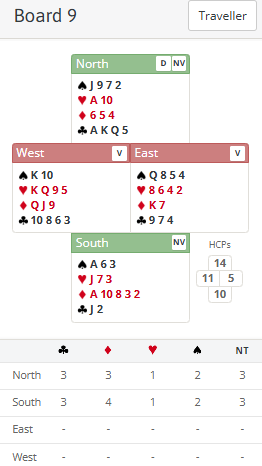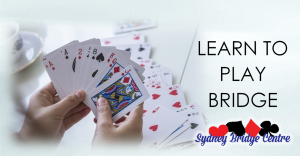City and Canada Bay – Thursday Morning 1st May 2025.

Board 9 last week saw most North South pairs playing in no-trumps. 9 tricks were available but many pairs didn’t make that many.
First the auction. North will open 1♣ (or a weak NT if playing that). South responds 1♦. West might have doubled had he had both majors but with only 2 spades he can’t really risk bidding. North should then rebid 1NT – it’s a lot better to describe the general nature of his hand than bid 1♠. There are ways to still find a spade fit if one exists and reserving a rebid of a 2nd suit for an unbalanced hand is also useful – see advanced section for more.
After a 1NT rebid showing 11-14 South is close to moving towards game but generally 10 points isn’t enough. A good rule of thumb is if the MAXIMUM your side can have is 24 then don’t invite game. 11 and 12 point hands are also more common than 14 so if you do invite you risk getting to 2NT with a combined 21-22 points and going off more often than you reach 3NT making. The two aces and the 5 card diamond suit are obviously good features about South’s hand but the two jacks are not.
So the final contract was most often 1NT. Frequently it was played by South so I imagine at those tables North did rebid 1♠ and South then bid 1NT. Not ideal since he has no heart stopper but it’s the only really practical thing he can do.
What about the play? West regularly led a heart, some Easts also did but other might have tried a spade. It shouldn’t matter. The defence don’t have time to set enough tricks up provided declarer just plays on his own long suit – diamonds. The best play after ♥5 lead is to win ♥10 at trick 1 (being relieved that West has led from ♥KQxx!) and then duck a diamond.
The defence can continue hearts which will set up 2 tricks for them there. But declarer just gives up another diamond. When they break 3-2 he has 3 diamonds to go with 1 spade, 2 hearts and 4 clubs. That would be 10 tricks but by then the defence already have 4 (2 hearts and 2 diamonds).
I imagine after the 2nd heart quite a few declarers cashed out for 8 tricks (taking 1 spade, 2 hearts, 1 diamond and 4 clubs). But you can frequently tell from the spot cards lead in hearts that the suit is breaking 4-4. That makes it safe to duck another diamond. See advanced section for more.
It’s quite common in no-trumps to need to duck tricks early in a suit to preserve your own communications. Diamonds here are a good example – particularly if the defence have attacked spades to knock ♠A out of the South hand. That makes it essential for declarer to duck two diamonds and preserve the ♦A for later to reach his long diamond tricks. Note the spade pips are important to give declarer two spade stops. Work through what could happen. Low spade from East ducked to ♠K. Now if West continues ♠10 declarer can cover it and his ♠9 becomes a trick.
Key points to note
It’s generally better to rebid NT with a balanced hand even if you could rebid a major. There are other ways to still find the major fit.
In balanced hand no-trump auctions if you discover your side has a maximum of 24 points then you generally should not invite game. Especially playing pairs.
In no-trumps ducking the first round, or even two rounds, of a side can help set up long tricks and keep an entry to them.
Watch the spot cards led and played in a suit by the defenders. They will often reveal how a suit is breaking. Here if declarer thinks hearts are 4-4 it’s quite safe to duck a 2nd diamond.
More advanced
After 1A-1B it’s a good idea to rebid 1NT with the relevant values even if you could rebid 1 major. That gives a better overall description of your hand.
It’s then common to play various forms of checkback to investigate major suit fits.
– One is to play 2♣ as checkback – partner responds with 2 of responder’s major with 3 card support or bids an unshown 4 card major.
– Another is to play 2 of an unbid minor as the same checkback.
– A third (my preference) is “two way checkback” where 2♣ forces partner to respond 2♦ and subsequent actions are all invitational (except a pass of 2♦ of course which responder might do with a weak hand with 6 diamonds and a 4 card major). 2♦ is an artificial game force – the responses are broadly the same but this time there’s plenty of room to explore all possible 5-3 or 4-4 fits because a game force has been established early on. Note the 2♣ and 2♦ bids apply regardless of whether the pair has bid clubs or diamonds so far.
The only time this rebid style loses is when responder isn’t strong enough to move over a 1NT rebid. It’s then possible that a 4-4 spade fit will be missed (imagine a bidding sequence 1♣-1♥-1NT where responder is 44 in the majors with a weak hand and opener is something like 4324 shape).
But the bigger overall gain from this method comes from the inference that when you do NOT rebid no-trumps then you show an unbalanced hand. So for example 1♣ 1♥-1♠ will now either be 4144 or will have at least 4 spades and at least 5 clubs. The knowledge that partner has an unbalanced hand can be very valuable – either in the auction or potentially in the defence if your side ends up defending.
Although it’s irrelevant on this hand the heart suit is worth a mention. No-trumps is better played by North with the ♥A10 doubleton holding. That’s because when partner has ♥Jxx you are guaranteed 2 stops no matter what the defence do (they would need to expend an honour to knock out the ace but now the remaining 10 opposite Jx are worth a 2nd stopper). Played by South that’s not the case. Imagine the honours had been split. West could lead through the ♥A10. East wins his honour and now the defence just duck to the singleton ♥A on the next round. This would leave declarer with only 1 stopper and the defence with 3 hearts (more if the suit didn’t break 4-4). So if you have a choice in the auction which player might end up as declarer a holding like A10 tends to be better as declarer than dummy.
I said you can often tell from the pips lead that a suit is splitting 4-4. You need to check your opponents’ leading methods of course. And then watch the spot cards carefully. But many pairs lead 4th highest. After ♥5 from West and ♥10 scoring, the 2nd heart he plays would normally be the 5th highest if he started with more than 4. So when West plays ♥9 on the 2nd round and East plays the ♥2 followed by the ♥4 that looks very like the suit is breaking 4-4. Declarer might try cashing 4 rounds of clubs to find out how that suit is breaking and see what the defence discard. Here East would probably discard a heart on the 4th club which also suggests the hearts are breaking. That makes it safe to duck another diamond. Even if hearts did break 5-3 ducking a 2nd diamond is still no worse. The defence may score 3 hearts and 2 diamonds but that’s all they get – so declarer still makes the 8 tricks he had anyway but makes 9 when hearts do split 4-4.
Julian Foster (many times NSW representative) ♣♦♥♠



